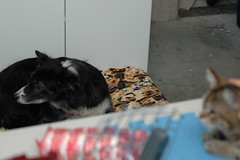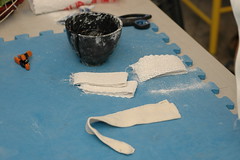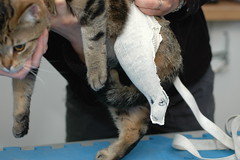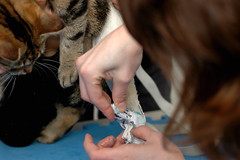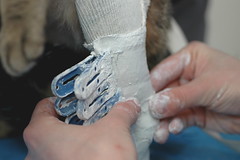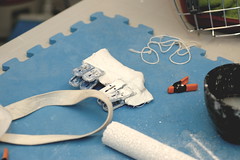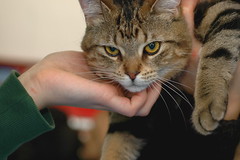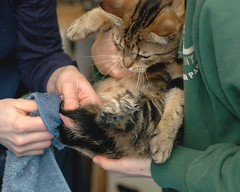A lot of my computer gaming came, unfortunately, before there were very many cool computer games and before I could afford the few cool computer games that existed. As a result of this, as a teenager, I played a lot of hearts in Windows 98.
Hearts is scored like golf: lower is better. Each heart you hold at the end of a hand is a point against you. The goal of the game is to wind up with as few hearts in your pile as possible. Except there's this thing called "shooting the moon," whereby you collect all the hearts in a hand and instead of adding 26 points to your score, you subtract 26 points from your score. Obviously this is quite a risky move, since, if you miss a single heart you are screwed.
I sort of feel this way about the idea of using technology to "fix" the environment. This planet has had a few billion years to work out the kinks. Humans, on the other hand, have had a scant few hundred thousand years to get themselves together and an even shorter time to figure out all this science and technology stuff.
Don't get me wrong: all this science and technology stuff is fabulous. I have been studying both quite hard for quite some time now and I still find them fascinating. I think using science and technology as a way to improve human life is a great boon to the generations surrounding mine. But technology is rarely without its consequences, frequently unintended, sometimes harmful to the environment.
The idea of piling one technology on top of the other in an attempt to curb these deleterious effects while maintaining our own comfort brings me back to the game of hearts: if we are successful in chaining all those technologies together to cancel out their negative side effects, if we succeed at shooting the moon, then everybody wins. But if we miss just one link in the chain, we risk making the world very uncomfortable or even uninhabitable for humans.
Tuesday, March 31, 2009
Thursday, March 26, 2009
Deus Ex Radioactiva
When you get down to a very small level, sometimes refered to as the quantum level, the universe becomes a strange place, at least to our human sized preconcieved notions of How Things Work. Radioactive decay is an example of this sort of weirdness: we can never tell when a particular atom is going to decay, but if we have a big pile of them, we can say how long it will take for half of them to have undergone decay with pretty good certainty.
Let's assume for a moment that the Christians are right: God exists and He's a vicious tyrant bent on forcing His creations to live in eternal pain, but who has nonetheless managed to convince a handful of those creations that He is loving and kind and just, mainly so that they will go out and visit unspeakable horrors on His other creations.
It would not be unthinkable that a creature that clever would be able to set up the universe in such a way that His own presence would be undetectable. How might He go about doing that? Why, with quantum mechanics, of course! You see, He would make everything run according to some probabilistic law: the outcome of any particular event would be completely unpredictable, but the pattern of those outcomes would become quite apparent given a large enough sample set. In this way, He could intervene by changing the outcome of a single event without violating His own laws.
The result of this would be a completely undetectable God who was able to alter the universe in large and detectable ways. In fact, given the current body of evidence, this is about the only way God could exist. So there you have it, Christians: your God is the ultimate jerk who uses only your belief in Him to determine where you spend all enternity while covering His tracks and making it completely impossible to detect Him until Judgement Day. And to me, that sounds a lot like "He beats me because He loves me."
Let's assume for a moment that the Christians are right: God exists and He's a vicious tyrant bent on forcing His creations to live in eternal pain, but who has nonetheless managed to convince a handful of those creations that He is loving and kind and just, mainly so that they will go out and visit unspeakable horrors on His other creations.
It would not be unthinkable that a creature that clever would be able to set up the universe in such a way that His own presence would be undetectable. How might He go about doing that? Why, with quantum mechanics, of course! You see, He would make everything run according to some probabilistic law: the outcome of any particular event would be completely unpredictable, but the pattern of those outcomes would become quite apparent given a large enough sample set. In this way, He could intervene by changing the outcome of a single event without violating His own laws.
The result of this would be a completely undetectable God who was able to alter the universe in large and detectable ways. In fact, given the current body of evidence, this is about the only way God could exist. So there you have it, Christians: your God is the ultimate jerk who uses only your belief in Him to determine where you spend all enternity while covering His tracks and making it completely impossible to detect Him until Judgement Day. And to me, that sounds a lot like "He beats me because He loves me."
Sunday, March 1, 2009
The Six Million Dollar Cat
When I posted a while ago about our new cat, I was contacted by my friend J, who is studying to be Prosthetic-Orthotic Technician at George Brown College. She knows someone who does prostheses for dogs (and thus might have some insight into working with cats) and thought she might be able to make a project out of it. So yesterday, we crammed Carmen into her cage and hauled her up to PawsAbility, stopping to pick up J on the way. This entry will mainly be a blow-by-blow of the process, which was surprisngly fast and painless for everyone involved.
Janice, who runs Pawsability is a clinician, while my friend J is a technician. This means that Janice does most of the patient related things like making the cast, and J does most of the mechanical things, i.e. building the actual prosthesis. When we arrived, Janice greeted us. I panicked a bit when I realized that Janice's dog Kate was there.
Kate was very well behaved and didn't bark once while we were there. Carmen didn't seem to be bothered by Kate one bit; she was probably preoccupied by the thought that every time she goes in the cage, someone stabs her with a needle when she comes out. Luckily for her, that didn't happen this time.
Janice prepared a little sock to put over the leg to be cast, the residuum, to keep plaster out of the fur. She poured a bowl of hot water and cut some plaster strips. She explained that, rather than building a fully circumferential cast, she would wrap the plaster around and pinch it on one side. That way, while it was drying she could pry it off instead of having to wait for it to dry and then fire up the saw.
About halfway through, Janice had to stop and cut more strips because she didn't expect Carmen's leg to be so muscly. That's our girl!
Janice used clothespins to keep the cast pinched shut and used her fingers to ensure she got the shape of Carmen's residuum.
Only 5 to 10 minutes after beginning with the wet plaster, it was already stiff enough that she could peel it off and it would retain its shape. She did so, then pinched it back together and left it to set.
We dried off our unhappy kitty, stuffed her back into the cage, said goodbye to Janice and brought Carmen home. J told us to pick out some fun patterned baby socks to add some colour to the outside of the prosthesis. In a few weeks, we will take Carmen back to see Janice for fitting.
Carmen was surprisingly calm during the whole process — her usual response to being manhandled is to go stiff, which was helpful. After we brought her home she recovered almost immediately and this morning she followed me around meyowling while I made coffee just like usual. I'm not sure if she'll want to wear the thing once it's done but so far it's been a neat process and doesn't appear to have traumatised her. Also, I'm going to talk to J about adding a little rocket booster and maybe the ability to leap tall buildings in a single bound.
Janice, who runs Pawsability is a clinician, while my friend J is a technician. This means that Janice does most of the patient related things like making the cast, and J does most of the mechanical things, i.e. building the actual prosthesis. When we arrived, Janice greeted us. I panicked a bit when I realized that Janice's dog Kate was there.
Kate was very well behaved and didn't bark once while we were there. Carmen didn't seem to be bothered by Kate one bit; she was probably preoccupied by the thought that every time she goes in the cage, someone stabs her with a needle when she comes out. Luckily for her, that didn't happen this time.
Janice prepared a little sock to put over the leg to be cast, the residuum, to keep plaster out of the fur. She poured a bowl of hot water and cut some plaster strips. She explained that, rather than building a fully circumferential cast, she would wrap the plaster around and pinch it on one side. That way, while it was drying she could pry it off instead of having to wait for it to dry and then fire up the saw.
About halfway through, Janice had to stop and cut more strips because she didn't expect Carmen's leg to be so muscly. That's our girl!
Janice used clothespins to keep the cast pinched shut and used her fingers to ensure she got the shape of Carmen's residuum.
Only 5 to 10 minutes after beginning with the wet plaster, it was already stiff enough that she could peel it off and it would retain its shape. She did so, then pinched it back together and left it to set.
We dried off our unhappy kitty, stuffed her back into the cage, said goodbye to Janice and brought Carmen home. J told us to pick out some fun patterned baby socks to add some colour to the outside of the prosthesis. In a few weeks, we will take Carmen back to see Janice for fitting.
Carmen was surprisingly calm during the whole process — her usual response to being manhandled is to go stiff, which was helpful. After we brought her home she recovered almost immediately and this morning she followed me around meyowling while I made coffee just like usual. I'm not sure if she'll want to wear the thing once it's done but so far it's been a neat process and doesn't appear to have traumatised her. Also, I'm going to talk to J about adding a little rocket booster and maybe the ability to leap tall buildings in a single bound.
Subscribe to:
Posts (Atom)
